Weijian Luo
Rewards Are Enough for Fast Photo-Realistic Text-to-image Generation
Mar 17, 2025Abstract:Aligning generated images to complicated text prompts and human preferences is a central challenge in Artificial Intelligence-Generated Content (AIGC). With reward-enhanced diffusion distillation emerging as a promising approach that boosts controllability and fidelity of text-to-image models, we identify a fundamental paradigm shift: as conditions become more specific and reward signals stronger, the rewards themselves become the dominant force in generation. In contrast, the diffusion losses serve as an overly expensive form of regularization. To thoroughly validate our hypothesis, we introduce R0, a novel conditional generation approach via regularized reward maximization. Instead of relying on tricky diffusion distillation losses, R0 proposes a new perspective that treats image generations as an optimization problem in data space which aims to search for valid images that have high compositional rewards. By innovative designs of the generator parameterization and proper regularization techniques, we train state-of-the-art few-step text-to-image generative models with R0 at scales. Our results challenge the conventional wisdom of diffusion post-training and conditional generation by demonstrating that rewards play a dominant role in scenarios with complex conditions. We hope our findings can contribute to further research into human-centric and reward-centric generation paradigms across the broader field of AIGC. Code is available at https://github.com/Luo-Yihong/R0.
Self-Guidance: Boosting Flow and Diffusion Generation on Their Own
Dec 08, 2024



Abstract:Proper guidance strategies are essential to get optimal generation results without re-training diffusion and flow-based text-to-image models. However, existing guidances either require specific training or strong inductive biases of neural network architectures, potentially limiting their applications. To address these issues, in this paper, we introduce Self-Guidance (SG), a strong diffusion guidance that neither needs specific training nor requires certain forms of neural network architectures. Different from previous approaches, the Self-Guidance calculates the guidance vectors by measuring the difference between the velocities of two successive diffusion timesteps. Therefore, SG can be readily applied for both conditional and unconditional models with flexible network architectures. We conduct intensive experiments on both text-to-image generation and text-to-video generations across flexible architectures including UNet-based models and diffusion transformer-based models. On current state-of-the-art diffusion models such as Stable Diffusion 3.5 and FLUX, SG significantly boosts the image generation performance in terms of FID, and Human Preference Scores. Moreover, we find that SG has a surprisingly positive effect on the generation of high-quality human bodies such as hands, faces, and arms, showing strong potential to overcome traditional challenges on human body generations with minimal effort. We will release our implementation of SG on SD 3.5 and FLUX models along with this paper.
Schedule On the Fly: Diffusion Time Prediction for Faster and Better Image Generation
Dec 02, 2024



Abstract:Diffusion and flow models have achieved remarkable successes in various applications such as text-to-image generation. However, these models typically rely on the same predetermined denoising schedules during inference for each prompt, which potentially limits the inference efficiency as well as the flexibility when handling different prompts. In this paper, we argue that the optimal noise schedule should adapt to each inference instance, and introduce the Time Prediction Diffusion Model (TPDM) to accomplish this. TPDM employs a plug-and-play Time Prediction Module (TPM) that predicts the next noise level based on current latent features at each denoising step. We train the TPM using reinforcement learning, aiming to maximize a reward that discounts the final image quality by the number of denoising steps. With such an adaptive scheduler, TPDM not only generates high-quality images that are aligned closely with human preferences but also adjusts the number of denoising steps and time on the fly, enhancing both performance and efficiency. We train TPDMs on multiple diffusion model benchmarks. With Stable Diffusion 3 Medium architecture, TPDM achieves an aesthetic score of 5.44 and a human preference score (HPS) of 29.59, while using around 50% fewer denoising steps to achieve better performance. We will release our best model alongside this paper.
Denoising Fisher Training For Neural Implicit Samplers
Nov 03, 2024



Abstract:Efficient sampling from un-normalized target distributions is pivotal in scientific computing and machine learning. While neural samplers have demonstrated potential with a special emphasis on sampling efficiency, existing neural implicit samplers still have issues such as poor mode covering behavior, unstable training dynamics, and sub-optimal performances. To tackle these issues, in this paper, we introduce Denoising Fisher Training (DFT), a novel training approach for neural implicit samplers with theoretical guarantees. We frame the training problem as an objective of minimizing the Fisher divergence by deriving a tractable yet equivalent loss function, which marks a unique theoretical contribution to assessing the intractable Fisher divergences. DFT is empirically validated across diverse sampling benchmarks, including two-dimensional synthetic distribution, Bayesian logistic regression, and high-dimensional energy-based models (EBMs). Notably, in experiments with high-dimensional EBMs, our best one-step DFT neural sampler achieves results on par with MCMC methods with up to 200 sampling steps, leading to a substantially greater efficiency over 100 times higher. This result not only demonstrates the superior performance of DFT in handling complex high-dimensional sampling but also sheds light on efficient sampling methodologies across broader applications.
Diff-Instruct*: Towards Human-Preferred One-step Text-to-image Generative Models
Oct 28, 2024
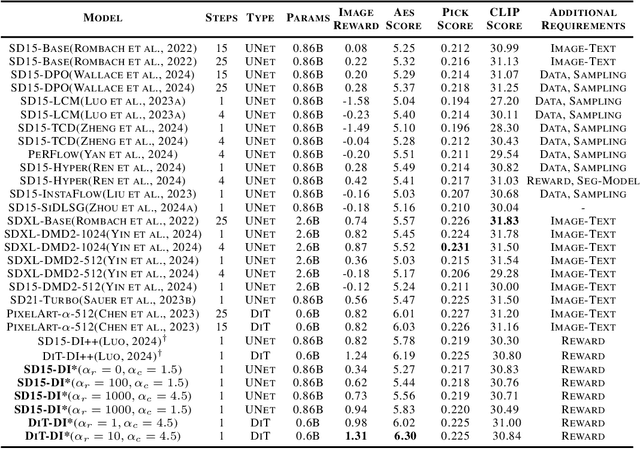

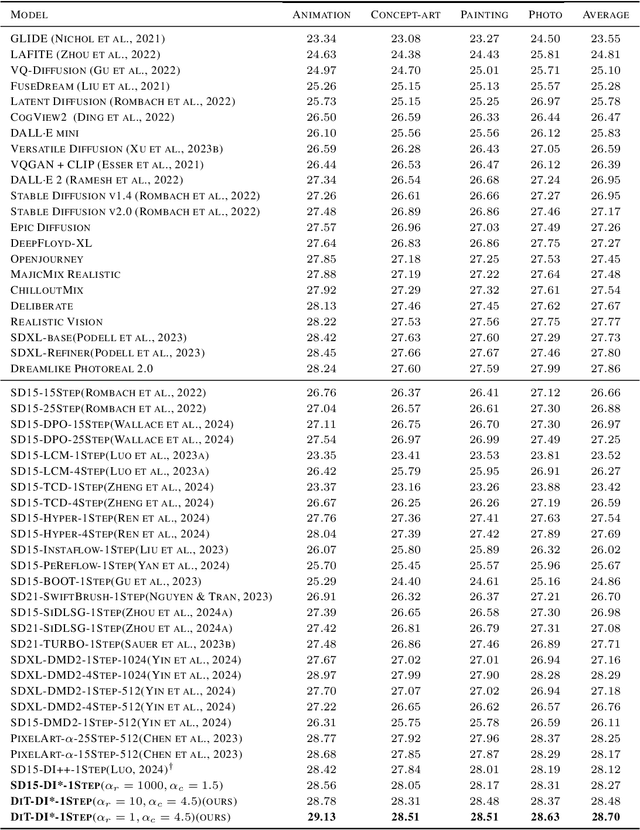
Abstract:In this paper, we introduce the Diff-Instruct*(DI*), a data-free approach for building one-step text-to-image generative models that align with human preference while maintaining the ability to generate highly realistic images. We frame human preference alignment as online reinforcement learning using human feedback (RLHF), where the goal is to maximize the reward function while regularizing the generator distribution to remain close to a reference diffusion process. Unlike traditional RLHF approaches, which rely on the KL divergence for regularization, we introduce a novel score-based divergence regularization, which leads to significantly better performances. Although the direct calculation of this divergence remains intractable, we demonstrate that we can efficiently compute its \emph{gradient} by deriving an equivalent yet tractable loss function. Remarkably, with Stable Diffusion V1.5 as the reference diffusion model, DI* outperforms \emph{all} previously leading models by a large margin. When using the 0.6B PixelArt-$\alpha$ model as the reference diffusion, DI* achieves a new record Aesthetic Score of 6.30 and an Image Reward of 1.31 with only a single generation step, almost doubling the scores of the rest of the models with similar sizes. It also achieves an HPSv2 score of 28.70, establishing a new state-of-the-art benchmark. We also observe that DI* can improve the layout and enrich the colors of generated images.
Flow Generator Matching
Oct 25, 2024



Abstract:In the realm of Artificial Intelligence Generated Content (AIGC), flow-matching models have emerged as a powerhouse, achieving success due to their robust theoretical underpinnings and solid ability for large-scale generative modeling. These models have demonstrated state-of-the-art performance, but their brilliance comes at a cost. The process of sampling from these models is notoriously demanding on computational resources, as it necessitates the use of multi-step numerical ordinary differential equations (ODEs). Against this backdrop, this paper presents a novel solution with theoretical guarantees in the form of Flow Generator Matching (FGM), an innovative approach designed to accelerate the sampling of flow-matching models into a one-step generation, while maintaining the original performance. On the CIFAR10 unconditional generation benchmark, our one-step FGM model achieves a new record Fr\'echet Inception Distance (FID) score of 3.08 among few-step flow-matching-based models, outperforming original 50-step flow-matching models. Furthermore, we use the FGM to distill the Stable Diffusion 3, a leading text-to-image flow-matching model based on the MM-DiT architecture. The resulting MM-DiT-FGM one-step text-to-image model demonstrates outstanding industry-level performance. When evaluated on the GenEval benchmark, MM-DiT-FGM has delivered remarkable generating qualities, rivaling other multi-step models in light of the efficiency of a single generation step.
Diff-Instruct++: Training One-step Text-to-image Generator Model to Align with Human Preferences
Oct 24, 2024



Abstract:One-step text-to-image generator models offer advantages such as swift inference efficiency, flexible architectures, and state-of-the-art generation performance. In this paper, we study the problem of aligning one-step generator models with human preferences for the first time. Inspired by the success of reinforcement learning using human feedback (RLHF), we formulate the alignment problem as maximizing expected human reward functions while adding an Integral Kullback-Leibler divergence term to prevent the generator from diverging. By overcoming technical challenges, we introduce Diff-Instruct++ (DI++), the first, fast-converging and image data-free human preference alignment method for one-step text-to-image generators. We also introduce novel theoretical insights, showing that using CFG for diffusion distillation is secretly doing RLHF with DI++. Such an interesting finding brings understanding and potential contributions to future research involving CFG. In the experiment sections, we align both UNet-based and DiT-based one-step generators using DI++, which use the Stable Diffusion 1.5 and the PixelArt-$\alpha$ as the reference diffusion processes. The resulting DiT-based one-step text-to-image model achieves a strong Aesthetic Score of 6.19 and an Image Reward of 1.24 on the COCO validation prompt dataset. It also achieves a leading Human preference Score (HPSv2.0) of 28.48, outperforming other open-sourced models such as Stable Diffusion XL, DMD2, SD-Turbo, as well as PixelArt-$\alpha$. Both theoretical contributions and empirical evidence indicate that DI++ is a strong human-preference alignment approach for one-step text-to-image models.
One-Step Diffusion Distillation through Score Implicit Matching
Oct 22, 2024



Abstract:Despite their strong performances on many generative tasks, diffusion models require a large number of sampling steps in order to generate realistic samples. This has motivated the community to develop effective methods to distill pre-trained diffusion models into more efficient models, but these methods still typically require few-step inference or perform substantially worse than the underlying model. In this paper, we present Score Implicit Matching (SIM) a new approach to distilling pre-trained diffusion models into single-step generator models, while maintaining almost the same sample generation ability as the original model as well as being data-free with no need of training samples for distillation. The method rests upon the fact that, although the traditional score-based loss is intractable to minimize for generator models, under certain conditions we can efficiently compute the gradients for a wide class of score-based divergences between a diffusion model and a generator. SIM shows strong empirical performances for one-step generators: on the CIFAR10 dataset, it achieves an FID of 2.06 for unconditional generation and 1.96 for class-conditional generation. Moreover, by applying SIM to a leading transformer-based diffusion model, we distill a single-step generator for text-to-image (T2I) generation that attains an aesthetic score of 6.42 with no performance decline over the original multi-step counterpart, clearly outperforming the other one-step generators including SDXL-TURBO of 5.33, SDXL-LIGHTNING of 5.34 and HYPER-SDXL of 5.85. We will release this industry-ready one-step transformer-based T2I generator along with this paper.
* Accepted by NeurIPS 2024
Integrating Amortized Inference with Diffusion Models for Learning Clean Distribution from Corrupted Images
Jul 15, 2024



Abstract:Diffusion models (DMs) have emerged as powerful generative models for solving inverse problems, offering a good approximation of prior distributions of real-world image data. Typically, diffusion models rely on large-scale clean signals to accurately learn the score functions of ground truth clean image distributions. However, such a requirement for large amounts of clean data is often impractical in real-world applications, especially in fields where data samples are expensive to obtain. To address this limitation, in this work, we introduce \emph{FlowDiff}, a novel joint training paradigm that leverages a conditional normalizing flow model to facilitate the training of diffusion models on corrupted data sources. The conditional normalizing flow try to learn to recover clean images through a novel amortized inference mechanism, and can thus effectively facilitate the diffusion model's training with corrupted data. On the other side, diffusion models provide strong priors which in turn improve the quality of image recovery. The flow model and the diffusion model can therefore promote each other and demonstrate strong empirical performances. Our elaborate experiment shows that FlowDiff can effectively learn clean distributions across a wide range of corrupted data sources, such as noisy and blurry images. It consistently outperforms existing baselines with significant margins under identical conditions. Additionally, we also study the learned diffusion prior, observing its superior performance in downstream computational imaging tasks, including inpainting, denoising, and deblurring.
Variational Schrödinger Diffusion Models
May 08, 2024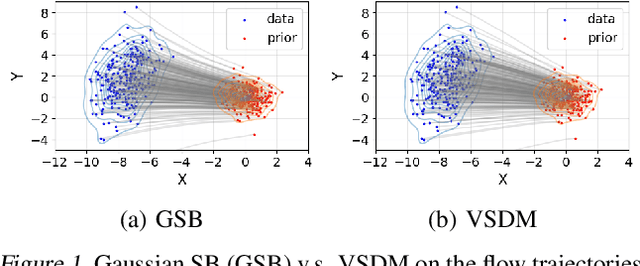

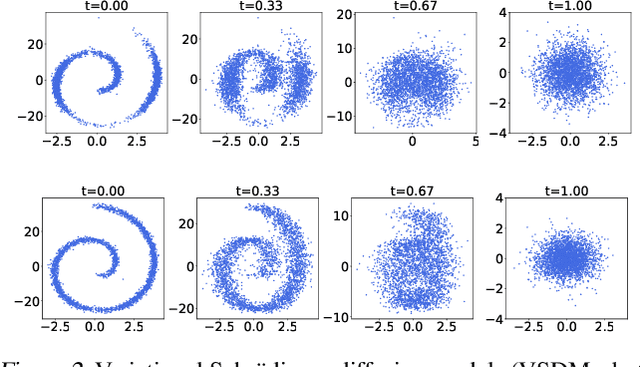
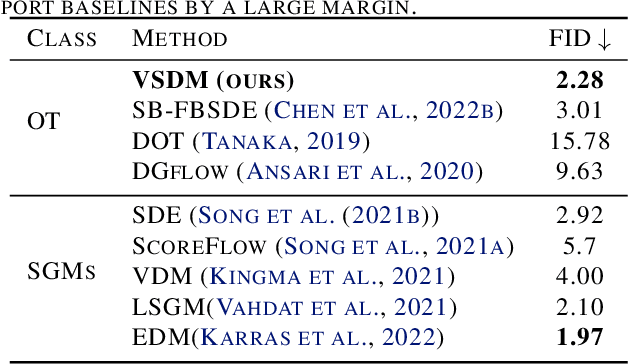
Abstract:Schr\"odinger bridge (SB) has emerged as the go-to method for optimizing transportation plans in diffusion models. However, SB requires estimating the intractable forward score functions, inevitably resulting in the costly implicit training loss based on simulated trajectories. To improve the scalability while preserving efficient transportation plans, we leverage variational inference to linearize the forward score functions (variational scores) of SB and restore simulation-free properties in training backward scores. We propose the variational Schr\"odinger diffusion model (VSDM), where the forward process is a multivariate diffusion and the variational scores are adaptively optimized for efficient transport. Theoretically, we use stochastic approximation to prove the convergence of the variational scores and show the convergence of the adaptively generated samples based on the optimal variational scores. Empirically, we test the algorithm in simulated examples and observe that VSDM is efficient in generations of anisotropic shapes and yields straighter sample trajectories compared to the single-variate diffusion. We also verify the scalability of the algorithm in real-world data and achieve competitive unconditional generation performance in CIFAR10 and conditional generation in time series modeling. Notably, VSDM no longer depends on warm-up initializations and has become tuning-friendly in training large-scale experiments.
 Add to Chrome
Add to Chrome Add to Firefox
Add to Firefox Add to Edge
Add to Edge